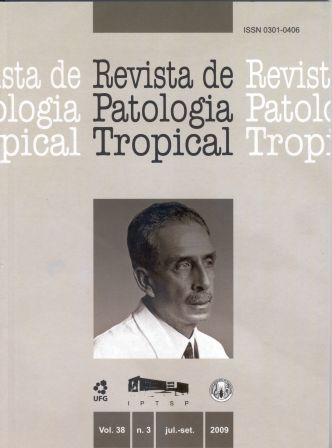Siphonaptera in rodents in the plague focus in Chapada do Araripe, Pernambuco, Brazil: 2000-2008
DOI:
https://doi.org/10.5216/rpt.v38i3.7840Keywords:
Siphonaptera Fleas, Plague, Yersinia pestis.Abstract
The occurrence of Siphonaptera, insects commonly known as fleas, in rodents trappedin the plague focus in Chapada do Araripe, Pernambuco State, Brazil was analyzed
aiming to subsidize the activities of the plague program control. In the period of
2002-2008, 1,719 specimens of fleas from rodents from nine municipalities in the
plague area were collected. Four species, Polygenis (Polygenis) bohlsi jordani,
Polygenis (Polygenis) tripus, Xenopsylla cheopis and Ctenocephalides felis felis
were collected from Necromys lasiurus (formely Bolomys lasiurus), Cerradomys
spp (formely Oryzomys subflavus), Thrichomys apereoides, Galea spixii, Rattus
rattus, Mus musculus. P. (P.) bohlsi jordani, was found in all species except M.
musculus; P. (P.) tripus in N. lasiurus, T. apereoides and R. rattus; X. cheopis in R.
rattus and M. musculus and C. felis felis in R. rattus. Yersinia pestis was not isolated
from fleas examined bacteriologically by culture and / or molecular techniques.
The presence of competent vectors and natural reservoirs demonstrates the bacteria transmission potential and therefore the need for maintaining and improving the
plague surveillance program in the foci, besides structuring a research program in
order to develop systematic studies on fleas and rodents.
Downloads
Downloads
Published
How to Cite
Issue
Section
License
The manuscript submission must be accompanied by a letter signed by all authors stating the full name and email address, confirming that the material has not been published or is under consideration for publication elsewhere, and agreeing to transfer copyright in all media and formats for Journal of Tropical Pathology. The authors will not be paid for published articles. They are solely responsible for the content of those articles, even if the Editor holds the right to adjust them to the norms of the journal.
The reviewers will not be paid for the peer review process.

